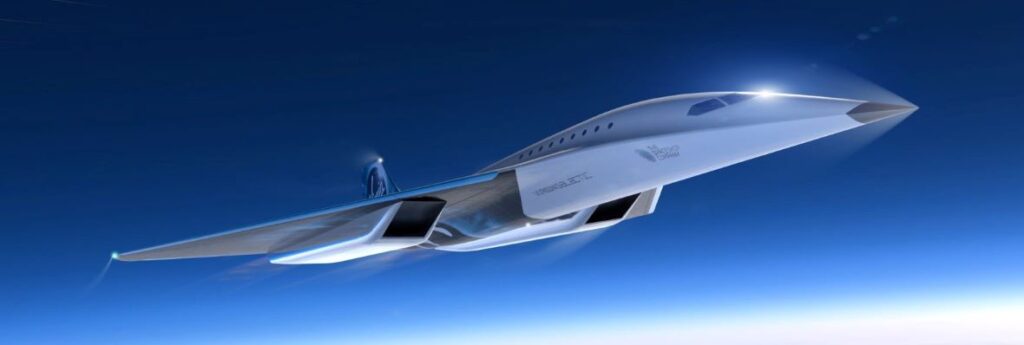Virgin Galactic’s in-progress supersonic jet is speeding towards construction, literally. The aircraft when complete would fly three times faster than the speed of sound and could fly between London and New York in about two hours – eclipsing by almost three hours the subsonic record set earlier this year.
The jet would be the fastest passenger aircraft to fly since the Concorde was grounded in 2003 and, indeed, the fastest ever civilian-certified plane – with the ability to reach speeds of Mach 3 (3,000 kph/2,300 mph) at an altitude of 60,000 feet. (The fastest-ever Concorde flight in 1996 took 2:53 at a top speed of 2,172 kph/1,350 mph).
Dubbed “son of Concorde,” development of the delta-wing aircraft by Virgin Galactic, which released the first stage design scope for the earthbound aircraft last week (see banner photo), is in addition to the company’s ongoing mission to send tourists into space.
Based on authorization for the project by the Federal Aviation Administration (FAA) Center, Virgin Galactic said that the engine technology for its high-speed aircraft would be designed and manufactured in collaboration with Rolls Royce, which had produced the Concorde’s propulsion system.
Previously, NASA signed a Space Act Agreement with Virgin Galactic to collaborate on high speed technologies.
The basic parameters of the initial aircraft design include a capacity for nine to 19 people and incorporate custom cabin layouts to address customer needs, including Business or First-Class seating arrangements.
The next phase of design will consist of defining specific system architectures and configurations and determining which materials to use in the design and manufacturing of the aircraft. Key challenges in thermal management, maintenance, noise, emissions, and the economics of high-speed commercial flights will also be addressed.
The design philosophy of the aircraft is geared around making high speed travel practical, sustainable, safe, and reliable, while making customer experience a top priority. Virgin Galactic is designing the aircraft for a range of operational scenarios, including service for passengers on long-distance commercial aviation routes. The aircraft would take off and land like any other passenger aircraft and be expected to integrate into existing airport infrastructure and international airspace around the world.
The aircraft design also aims to help lead the way toward use of state-of-the-art sustainable aviation fuel. Baselining sustainable technologies and techniques into the aircraft design early on is expected to also act as a catalyst to adoption in the rest of the aviation community.
While no timeline has been announced, Virgin Galactic Chief Space Officer George Whiteside says, “We have made great progress so far, and we look forward to opening up a new frontier in high-speed travel.”
Meanwhile, the company reported on Aug. 3 that the pandemic had slowed the pace of the company’s progress towards launching its first operational spaceflight and that passengers will have to wait until 2021 to have the opportunity to take off in the suborbital space plane SpaceShipTwo.

